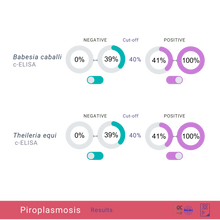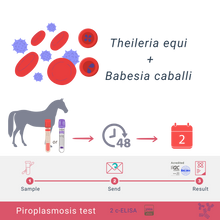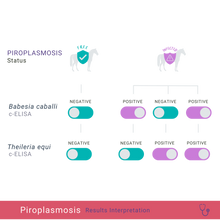
Our Equine Piroplasmosis Comprehensive Bundle offers the ultimate detection of Equine Piroplasmosis by combining cELISA, iFAT, and qPCR tests. This bundle is essential for early detection of infections, particularly during febrile peaks caused by piroplasms, and is crucial for the official trading, import, and export of horses.
Product Overview
The bundle includes:
- Two cELISA Tests: Detect antibodies to Babesia caballi and Theileria equi. Used for official trading and movement of horses. Follows ISO/IEC 17025 standards, ensuring high quality and reliability.
- iFAT Test: Indirect Fluorescent Antibody Test for detecting antibodies to Babesia caballi and Theileria equi. Follows ISO/IEC 17025 standards, ensuring high quality and reliability.
- qPCR Test: Detects the genome of Babesia caballi and Theileria equi, providing highly sensitive detection of piroplasms, ideal for early infection detection and during febrile peaks.
Sample Requirements
- 5 mL of blood or serum - collect blood in a dry tube for cELISA and iFAT
- 5 mL of blood - collect blood in K3 EDTA tube for qPCR
Turnaround Time
Standard Processing: Results in 2 working days after sample arrival at the laboratory. Clients are responsible for organizing and covering the costs of sending the samples to the laboratory.
What is Piroplasmosis?
Equine piroplasmosis (EP) is a tick-borne disease of horses caused by the intraerythrocytic protozoan parasites Babesia caballi and Theileria equi. These agents are transmitted through a tick vector. Infected animals may remain carriers of these blood parasites for long periods and act as sources of infection for other ticks. The parasites are found in southern Europe, Asia, countries of the Commonwealth of Independent States, Africa, Cuba, South and Central America, and parts of the southern United States.
Clinical Signs
- Incubation period: 12 to 19 days for T. equi and 10 to 30 days for B. caballi.
- Per-acute form: Rare, with only clinical observation being moribund or dead animals.
- Acute form: Fever, reduced appetite, elevated respiratory and pulse rates, congestion of mucous membranes, dark red urine, smaller and drier faecal balls, anaemia, and/or icterus.
- Subacute form: Similar to acute form but with weight loss and intermittent fever. Mucous membranes may vary from pale pink to bright yellow.
- Chronic form: Mild inappetence, poor performance, weight loss. Documented case fatality rates vary from 10–50%.
Transmission
Babesia caballi sporozoites invade red blood cells (RBCs), transforming into trophozoites which divide into merozoites, capable of infecting new RBCs. B. caballi can be found in various organs of tick vectors and transmit transovarially.
Theileria equi sporozoites, inoculated into horses via a tick bite, invade lymphocytes, develop into schizonts, and release merozoites that invade RBCs. T. equi develop in the salivary glands of the tick vector and are not transmitted transovarially. Transmission is also possible through mechanical vectors contaminated by infected blood.
Prevention
Sanitary Prophylaxis: Testing and controlling tick exposure, using repellents, acaricides, and regular inspections, controlling and eradicating the tick vector, and quarantining EP-positive animals.
Medical Prophylaxis: No current biological products are available. Antiprotozoal agents only temporarily clear T. equi from carriers.







